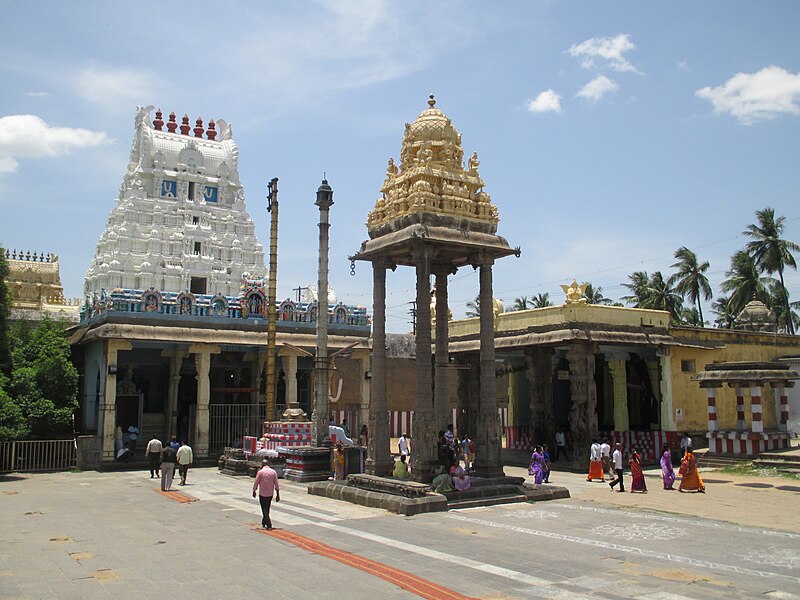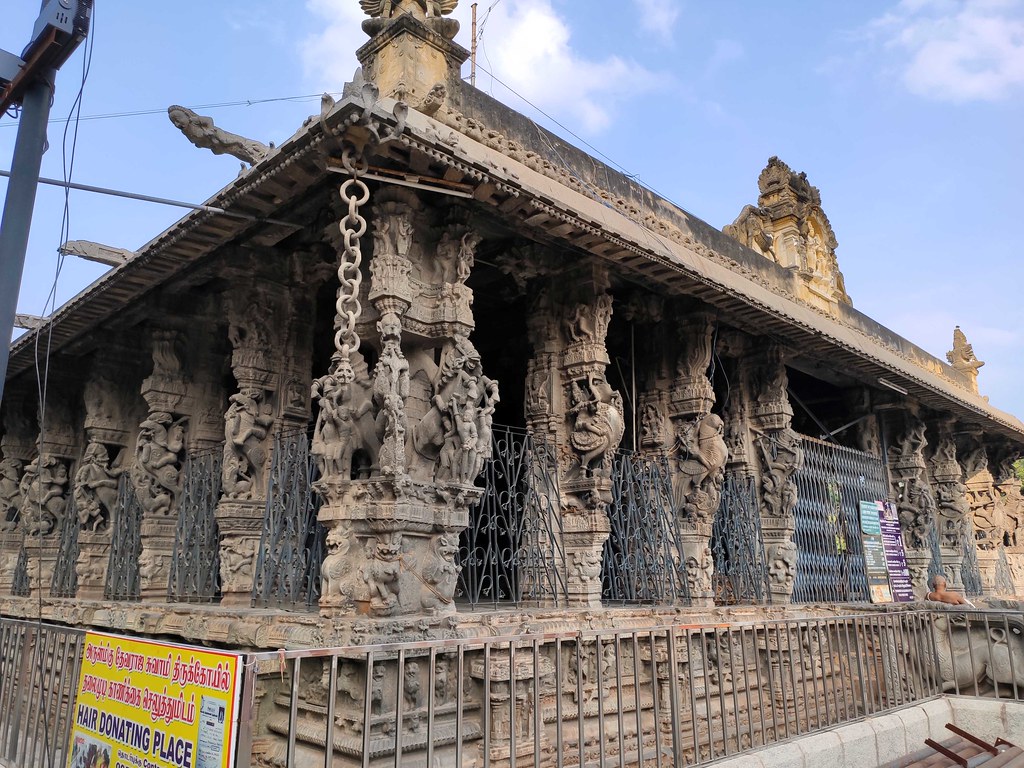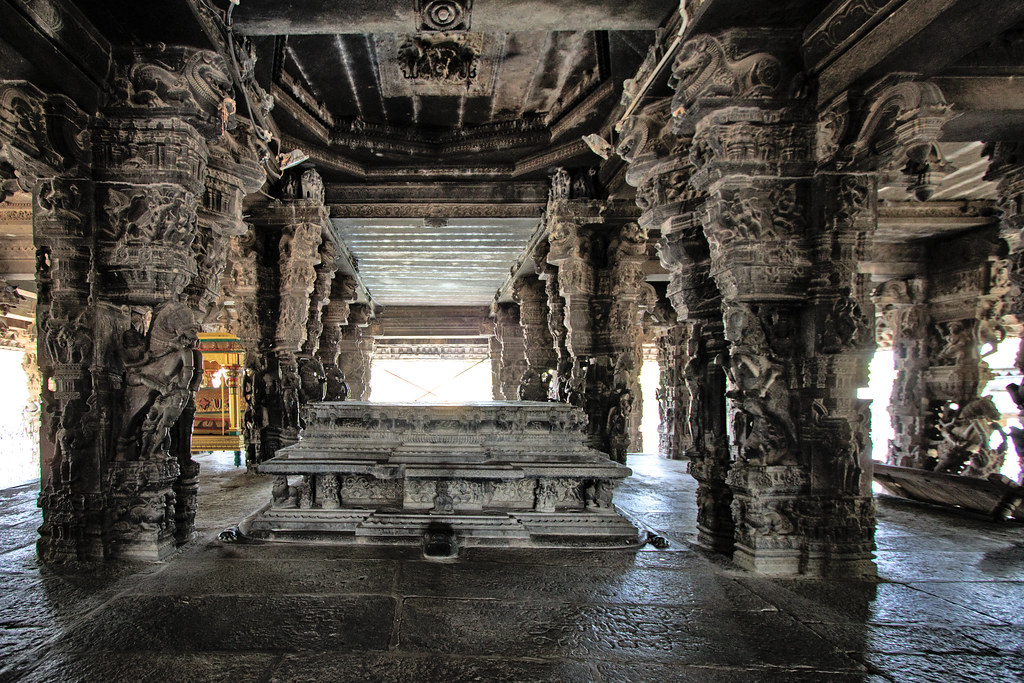ॐ श्री गुरुभ्यो नमः ॐ श्री शिवानन्दाय नमः ॐ श्री चिदानन्दाय नमःॐ श्री दुर्गायै नमः
Source of all Images in this Blog-post : Google Images : ‘Google Image Search’ will reveal the multiple sources of every single image shared here. For more details, kindly see ‘Disclaimer‘
A write-up on Sri Varadaraja Perumal Temple below the following images of the temple






Introduction
Nestled in the ancient city of Kanchipuram, Tamil Nadu, Sri Varadaraja Perumal Temple is a beacon of spiritual and architectural grandeur. This temple, dedicated to Lord Vishnu, is not just a pivotal religious site but also a symbol of the rich cultural tapestry of India. Its magnificent structure and deep-rooted spiritual traditions attract a plethora of pilgrims and tourists globally, making it a quintessential destination for those seeking a blend of divine experience and architectural splendor.
Legend
The temple is steeped in legends, with one of the most captivating being the story of Lord Brahma worshiping Lord Vishnu at this sacred site. Another intriguing legend is that of the idol of Athi Varadar, a deity carved from the holy fig tree, which is uniquely revered. According to belief, the idol was submerged in the temple tank to protect it from invaders and is brought out for worship once every 40 years, an event that transforms the city into a vibrant spiritual hub.
History
The origins of Sri Varadaraja Perumal Temple are shrouded in the mists of time, with references dating back to the early centuries of the common era. The temple gained prominence under the rule of the Cholas in the 11th century, who were instrumental in its initial architectural expansion. The subsequent centuries saw contributions from various dynasties, notably the Vijayanagar Empire. King Krishnadevaraya, among the most prominent of the Vijayanagar rulers, bestowed great wealth and added majestic structures to the temple in the 16th century, embedding his legacy within its walls.
The architectural grandeur of Sri Varadaraja Perumal Temple is a testament to the skill and artistry of ancient Indian craftsmen. Its towering gopurams (gateway towers) are adorned with intricate carvings and painting, standing as silent sentinels of the city’s glorious past. Inside, the 100-pillared hall, a hallmark of Vijayanagar architecture, is an astonishing gallery of sculptures depicting various incarnations of Vishnu and scenes from Hindu epics. The finesse of the stone work in this hall is a profound statement of the artistic zenith reached in ancient India.
Description of Architecture in Detail
The Gopurams and Temple Complex
Sri Varadaraja Perumal Temple’s architectural splendor begins with its imposing gopurams (tower gateways). These structures are not just gateways but also serve as towering symbols of Dravidian architectural prowess. The intricate carvings on the gopurams depict a plethora of deities, mythological creatures, and floral motifs, each narrating a story from the Hindu epics. The tallest among these, the eastern gopuram, stands as a beacon, visible from miles around and inviting pilgrims into the sacred precincts.
The Sanctum Sanctorum
The sanctum sanctorum, housing the deity of Lord Varadaraja, is a masterpiece of ancient temple architecture. The vimana (tower over the sanctum) is adorned with detailed sculptures and crowned with a golden dome, symbolizing the celestial abode of Vishnu. The sanctum is designed to allow natural light to fall directly on the deity, especially during specific times of the year, signifying divine presence and blessings.
The 100-Pillared Hall
Beyond the towering gopurams and the sanctum sanctorum lies the famed 100-pillared hall, an exemplary illustration of Vijayanagar architecture. Each pillar here is a sculptural marvel, intricately carved with images of gods, goddesses, mythical animals, and scenes from Hindu legends. The precision of the carvings and the fluidity of the sculptures demonstrate the extraordinary skill of the artisans. This hall is not just a place of worship but also a gallery showcasing the zenith of medieval South Indian art.
The Temple Tank and the Surroundings
Adjacent to the temple is the sacred temple tank, known as Anantha Saras, integral to the temple’s rituals and legends. The steps leading to the water are symmetrically aligned, demonstrating the importance of geometry and balance in temple architecture. The tank’s presence adds a serene and contemplative dimension to the temple complex, offering a space for reflection and meditation.
Artistic Embellishments and Symbolism
Every element of the temple, from the towering gopurams to the smallest relief, is imbued with symbolism. The temple walls and pillars are adorned with an array of sculptures and frescoes, each serving as a testament to the religious and cultural milieu of the times. The use of color, particularly in the frescoes, adds vibrancy and life to the stone structures, depicting scenes from the Puranas and the life of Lord Vishnu in vivid detail.
Integration with the Natural Environment
The temple’s layout and architecture are harmoniously integrated with the natural surroundings, exemplifying the ancient Indian architectural principle of blending man-made structures with nature. The placement of the temple complex, the orientation of the sanctum, and the alignment of the various structures are thoughtfully designed to harness the natural elements, such as sunlight and wind, enhancing the spiritual ambiance.
In summary, the architectural brilliance of Sri Varadaraja Perumal Temple is not just in its grand structures but also in the intricate details that adorn every corner of the temple. Its design is a confluence of artistic mastery, spiritual symbolism, and ancient architectural wisdom, making it a timeless marvel in the world of religious architecture.
Mentions in Ancient Literature
Sri Varadaraja Perumal Temple finds frequent mentions in ancient Tamil literature, particularly in the hymns of the Alvars. These sacred texts, composed between the 6th and 9th centuries, celebrate the temple as a divine abode, thus underlining its historical and religious importance. The temple is also featured in various medieval historical records, adding layers to its rich cultural narrative.
Expanding on the mention of Sri Varadaraja Perumal Temple in ancient literature, we find a rich tapestry of references that underscore its historical and spiritual significance:
The Alvars and the Divya Prabandham
The most prominent mentions of Sri Varadaraja Perumal Temple in ancient literature come from the Tamil saint-poets known as the Alvars. These mystic poets composed hymns in praise of Vishnu, collectively known as the Divya Prabandham, between the 6th and 9th centuries CE. Among these, the temple is vividly described in the verses of Thirumangai Alvar and Bhoothath Alvar. These hymns not only glorify the deity but also provide insights into the temple’s architecture, rituals, and the religious practices of the time.
The Vaikuntha Perumal Temple Inscriptions
While not a literary source in the traditional sense, the inscriptions in the nearby Vaikuntha Perumal Temple, another significant Vishnu temple in Kanchipuram, provide valuable historical context. These inscriptions, dating back to the Pallava dynasty, mention the Varadaraja Perumal Temple and shed light on the religious and social landscape of Kanchipuram during the early medieval period.
The Silappadikaram
One of the five great epics of Tamil literature, the Silappadikaram, written by Ilango Adigal, makes indirect references to the religious practices and deities that bear a resemblance to those in the Varadaraja Perumal Temple. Although the temple is not mentioned by name, the descriptions of Vishnu worship and the rituals mirror those associated with the temple.
The Periya Puranam
The Periya Puranam, a 12th-century Tamil work by Sekkizhar, which narrates the lives of the 63 Nayanmars (Shaivite saints), also mentions the city of Kanchipuram and its religious significance. This work, while primarily focused on Shaivism, provides a broader context of the religious milieu in which the Varadaraja Perumal Temple existed and flourished.
Medieval Travelers’ Accounts
The accounts of medieval travelers, both from within India and from foreign lands, serve as an invaluable source of information about Sri Varadaraja Perumal Temple. These writings often describe the temple’s architecture, the deity, and the festivals in detail. They provide an outsider’s perspective on the temple’s importance and its role in the cultural and religious life of Kanchipuram.
Regional Chronicles and Royal Records
Various regional chronicles and royal records of the dynasties that ruled over Kanchipuram, such as the Cholas, Pandyas, and the Vijayanagar Empire, include references to the Sri Varadaraja Perumal Temple. These records often detail the contributions made by kings to the temple, in the form of renovations, donations, and the organization of festivals, highlighting the temple’s prominence through different historical eras.
Through these diverse ancient literary and historical sources, the Sri Varadaraja Perumal Temple emerges not only as a center of Vaishnavite worship but also as a significant cultural and historical landmark, deeply intertwined with the religious, social, and political fabric of Tamil Nadu over the centuries.
Festivals and religious practises
The temple’s religious calendar is a vibrant tapestry of festivals, each a spectacle of devotion and celebration. The Brahmotsavam, celebrated in the Tamil month of Vaikasi, is particularly grand, with processions, rituals, and cultural events that transform Kanchipuram into a carnival of spiritual ecstasy. The emergence of Athi Varadar from the temple tank is a phenomenon that transcends mere religious festivity, drawing millions from around the globe, eager to witness and partake in this rare celestial event.
Sri Varadaraja Perumal Temple in Kanchipuram is renowned for its elaborate and vibrant religious festivals that attract thousands of devotees and tourists every year. Each festival celebrated here is steeped in tradition and offers a unique glimpse into the rich tapestry of Hindu religious practices.
Detailed Account of Religious Festivals at Sri Varadaraja Perumal Temple
1. Brahmotsavam
The most significant festival celebrated at the temple is the Brahmotsavam, usually held in the Tamil month of Vaikasi (May-June). This grand festival lasts for ten days and is marked by the procession of the deity in various vahanas (celestial vehicles). Each day of Brahmotsavam has its own unique rituals and celebrations, including the Garuda Sevai, where the deity is carried on a Garuda (eagle) vahana, attracting large crowds.
2. Vaikunta Ekadasi
Vaikunta Ekadasi, celebrated in the Tamil month of Margazhi (December-January), is another major festival. It marks the opening of the Vaikunta Vasal (Gateway to Heaven), and devotees believe that passing through this gate on this auspicious day leads to salvation. Special prayers, music, and recitation of the Vedas accompany the festivities.
3. Pavitrotsavam
Pavitrotsavam is observed typically in the Tamil month of Aadi (July-August). This festival is dedicated to the purification of the temple and its deities. Rituals performed during this festival are believed to rectify any shortcomings in the daily worship practices throughout the year.
4. Float Festival (Teppotsavam)
Teppotsavam, the float festival, occurs in the Tamil month of Masi (February-March). The festival features the deities being taken in a procession to the temple tank, where they are placed on a decorated float. Devotees gather to witness the deities riding the float across the tank amidst chanting and music.
5. Athi Varadar Festival
The unique Athi Varadar festival, held once in 40 years, involves the raising of the Athi Varadar deity from the temple tank. This rare event lasts for 48 days, during which the deity is placed for public viewing and worship. The festival is marked by elaborate rituals and attracts devotees from all over the world.
6. Navaratri
Navaratri, celebrated for nine nights, is dedicated to the Goddess. Although a festival more associated with the Goddess, it is also celebrated in the Varadaraja Perumal Temple with special pujas and cultural programs. Each night is dedicated to a different form of the Goddess.
7. Ratha Sapthami
Ratha Sapthami, or Surya Jayanti, celebrated in the Tamil month of Thai (January-February), marks the deity’s procession on a chariot around the temple. It symbolizes the Sun God’s chariot and is a celebration of life and energy.
8. Deepavali and Pongal
Deepavali and Pongal, although primarily societal festivals, are also celebrated in the temple with special prayers and offerings. These festivals are times of communal harmony and joy, reflecting the cultural fabric of Tamil Nadu.
Each festival at the Sri Varadaraja Perumal Temple is a blend of devotion, tradition, and cultural extravaganza, offering a vivid experience of South Indian religious practices and celebrations. These festivals not only uphold the temple’s religious significance but also play a crucial role in preserving and propagating the rich cultural heritage of the region.
Atthi Varadar
The enigmatic deity Athi Varadar, central to the temple’s lore, is revered not just for its spiritual significance but also for the unique ritual associated with it. The idol’s emergence from the Anantha Saras tank, where it remains submerged and preserved, is an event that occurs once in 40 years, attracting devotees from all corners of the world. This rare ritual is not just a religious ceremony but a cultural phenomenon, showcasing the enduring power of faith and tradition in the Indian subcontinent.
In summary, Sri Varadaraja Perumal Temple is more than just a temple; it is a living museum of Indian history, a canvas of ancient art, and a pulsating center of spirituality. Its timeless architecture, rich legends, and dynamic festivals make it an irresistible attraction for tourists and pilgrims from around the world, offering a glimpse into the soul of Indian heritage and spirituality.
Divya Desham
The temple is exalted as one of the 108 Divya Deshams – the holy shrines of Vishnu. These shrines were glorified in the hymns of the Alvars, the saint poets of Tamil Nadu, whose devotional outpourings are central to Vaishnavite theology. The temple’s inclusion in this revered list elevates its spiritual significance, drawing devout Vaishnavites from across the world.
Conclusion
In conclusion, the Sri Varadaraja Perumal Temple of Kanchipuram is not just a landmark of religious importance, but a monumental testament to India’s rich cultural and historical legacy. Its stunning architecture, steeped in centuries of history, stands as a witness to the artistic and spiritual achievements of ancient Indian civilizations. The temple’s legends and rituals, particularly those surrounding the enigmatic Athi Varadar, weave a tapestry of faith and tradition that resonates deeply with the devotees.
This temple, with its divine ambiance, architectural marvels, and vibrant festivals, offers a unique and profound experience that goes beyond mere sightseeing. It’s a journey into the heart of Indian spirituality, an exploration of artistic mastery, and a gateway to understanding the intricate layers of Hindu mythology and culture. As a hub for pilgrims and a beacon for tourists worldwide, the Sri Varadaraja Perumal Temple encapsulates the essence of India’s enduring spiritual allure and stands as a symbol of universal harmony and devotion.
Whether one seeks spiritual solace, historical insight, or architectural beauty, the temple serves as a perfect destination, promising an unforgettable experience that lingers long after the visit. It beckons not just the faithful but anyone who wishes to delve into the depths of India’s ancient traditions and experience the vibrancy of its living culture. In the heart of Kanchipuram, the Sri Varadaraja Perumal Temple remains an eternal source of inspiration, devotion, and awe, inviting the world to discover its timeless splendor.
